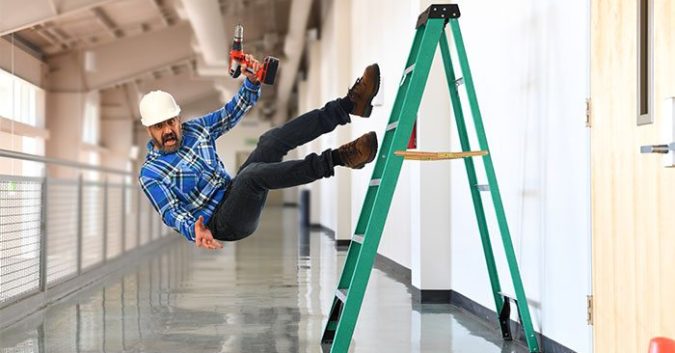Accidental slips and falls in the workplace are among the leading causes of work-related injury – or death – in the United States. According to the National Floor Safety Institute (NFSI), falls account for over 8 million emergency room visits and cause 15 percent of all accidental deaths.
Up until recently, OSHA only enforced fall prevention standards for employers in construction, the industry in which these accidents are the biggest problem. Now, the rules have been expanded to cover all industries, affecting 112 million people at 7 million workplaces.
A Long-Needed Update
Seven years after the Occupational Safety and Health Administration (OSHA) first proposed regulations to govern slip and fall prevention for all industries, new final rules will go into effect on January 17.
The rules address slip and fall incidences in the U.S. by bringing industry standards firmly up-to-date, focusing primarily on equipment but also practices used to prevent accidents. The existing standards have not been updated since 1971.
Requirements apply to all so-called “walking-working surfaces,” described by OSHA as “any horizontal or vertical surface on or through which an employee walks, works, or gains access to a workplace location.” These could be floors, stairs, roofs, ladders, ramps, or scaffolds, for example. The final rule covers general industry firms such as building management services, retail, outdoor advertising, and utilities.
Although the rules are soon to begin going into effect, deadlines have been extended as many as 20 years from now to allow for installation of new safety systems, training, and inspection.
Employers are also given flexibility in how they meet compliance standards. They can choose what works best for their employees in particular circumstances from a selection of acceptable safety systems, including guardrails, safety nets, and handrails.
Finally, employees must be trained by a “qualified person” on correct procedures for using fall protection equipment and minimizing hazards. Training must cover areas such as proper use of systems, identification of fall hazards, and maintenance and storage of equipment.
OSHA provides employers with extensive compliance assistance resources to guide employers on best practices for employee protection, which includes general information on the website, in webinars and training programs, and advice from Compliance Assistance Specialists. In doing so, the agency gives employers no excuse to cut corners.
How Serious Is the Slip and Fall Problem?
Over 1 million Americans every year suffer slips, trips, or falls often due to employer workplace negligence. These accidents have a wide range of consequences from moderate to severe injuries to disabilities or long-term medical complications, or even death.
To put this type of accident into further perspective, slips and falls make up 12 to 15 percent of all Workers’ Compensation expenses, costing $70 Billion annually in compensation and medical costs.
The Centers for Disease Control and Prevention (CDC) and U.S. Bureau of Labor Statistics (BLS) describe 2 types of falls: elevated and same-level. The latter accounts for 65 percent of workplace accidents. Leading causes of slips or falls include uneven or slippery floors or working surfaces, discarded materials or debris, and poorly designed or maintained ladders or stairways.
Now that regulations are set to span across all industries, the hope is that it will not only benefit employers by improving consistency across industries, but it will also eliminate hazards and increase employee safety and peace of mind.
Will the Final Rule Make a Difference?
OSHA claims that key motivations for this rule were to keep up with technological advancements and provide cost-effective worker protection.
“OSHA believes advances in technology and greater flexibility will reduce worker deaths and injuries from falls,” said OSHA chief David Michaels, who is also Labor Department assistant secretary for occupational safety and health.
Of course, many firms within general industries have started availing the latest technology and are already implementing safety compliance – one of their motivations being to keep workers’ compensation and other insurance costs at a minimum. But many companies are still reluctant to take employee safety seriously, and are therefore contributing to increasing rates of accidents.
In addition, OSHA’s new regulations disregard Republican warnings to the Obama administration about issuing new final rules before Donald Trump’s presidency begins. So the question lingers of whether the Trump administration will allow employers more discretion or, worse, overturn these regulations altogether. But given that OSHA expects the final rule to prevent 29 fatalities and 5,842 lost-workday injuries annually, these regulations could be instrumental in bringing positive change for all workers.
